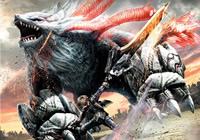God Eater 2: Rage Burst (PlayStation 4) Review
By Drew Hurley  29.08.2016
29.08.2016

The God Eater series, developed by Shift and produced by Bandai Namco, has been going since 2010 where the original game was released on PSP. It gained considerable popularity in Japan where it spawned two remakes, a sequel, and then the highly coveted manga and anime adaptations, too. Despite its popularity, the second in the series was never released outside of Japan. Now, the sequel is getting a remastered release with all of the DLC from the original, along with a ton of new Rage Burst content. Now that the game is finally here, was it worth the wait? Cubed3 finds out…
The God Eater series is something of a post-apocalyptic sci-fi tale, being set in the not too distant future where biological weapons, known as Aragami, have appeared across the world and began wiping out humanity. These creatures not only devoured any people unlucky enough to stand in their way, they also began destroying technology and resources. Humanity tried fighting back, but to no avail. The Aragami was nigh invulnerable compared to any weaponry that humanity deployed against it - until the creation of the God Arcs. These huge transformable weapons use the "Oracle Cells" of the very Aragami they were made to exterminate.
This sequel is set three years after the original game, and whilst humanity has finally begun fighting back against the Aragami, new threats have emerged. A red rain is falling from nimbus clouds, and those unfortunate enough to be caught in it contract a fatal disease known as The Black Plague, for which there is no known cure or even treatment. Worse still, a new type of Aragami, known as Psions, has appeared. These seem to be able to control other Aragami and also to disrupt the Oracle cells within the God Arc weapons. The player character is the latest recruit to "The Blood;" the most elite Special Forces unit from the organisation, fighting back against the Aragami, Fenrir. From the moving battle fortress, The Blood travels where needed to take on high-level threats, and now it is called to the Far East branch to see if it can help take on these new threats.

The adventure begins with a decent enough character creation screen; no sliders but enough variation to create a unique character. After establishing a look, along with a name, codename, and sex, an absolutely beautiful anime style intro commences, showing off some of the characters wielding their God Arc weapons, along with some of the Aragami that will need to be slaughtered over the course of the journey.
The God Eater games are of the "Hunting" variety, in the same vein as the mega-popular Monster Hunter releases. There have been plenty of contenders over the years that have tried to take the Hunting crown, most recently with Toukiden and Freedom Wars but, thus far, none has managed to surpass it. God Eater differs from Monster Hunter by relying on fast-paced combat, along with a much more story driven narrative. There is a sizeable cast of characters to interact with and an enjoyable and engaging story to play through. Each member of the cast also gets its own side stories, which can be unlocked later on by taking them on more missions and speaking with them often. Missions can be taken on solo, but it's rarely a good idea, and instead a team of up to four characters can be made up and later there are ways to unlock support and backup characters to assist in the missions, too.

Although every character is equipped with a God Arc, that doesn't mean they all fight the same. Every God Arc has the same transformation abilities - able to switch between melee weapon, ranged weapon and shield. Each of these transformations comes in a number of variations, though. The melee weapons can be set to quick one-handed "Short blade" (which is still around five to six foot long!), a two-handed middle ground "Long Blade," a buster sword, a gargantuan "Boost Hammer," a "Charge Spear," and a brand new form added to this iteration, the "Variant Scythe." Each of the weapons feels different enough and each has unlockable Blood Skills that are levelled up and unlocked through repeated use. Not to be outdone, the ranged weapons have a number of variations, as well. Fast firing "Assault" mode, long shooting "Sniper" mode, big damage "Blast mode," and the brand new "Shotgun" mode.
Regardless of the type of God Arc, they all have the ability to transform into a huge gaping maw to take a bite out of enemy Aragami. By biting living Aragami, the Oracle Cells are extracted from the Aragami and grant special bullets. Biting dead Aragami gives numerous different crafting materials to develop and upgrade equipment. There is a huge system of crafting, not only for the creation and enhancing of equipment but also a massive system around creating custom bullets that has surprising depth.

Compared to Monster Hunter, the combat in Rage Burst is much more fast paced and dynamic. While this may put off Monster Hunter die hard fans, the system is well developed and fun. The combat is fantastically enjoyable and quite addictive, to boot. Being able to tear enemies up with hack and slash attacks, and then quickly dodge and evade away to switch to gun mode and fill them with explosive rounds, is really exhilarating. Mastering each aspect of the equipment and then unlocking new abilities as the game progresses keeps the combat fresh, and by using plenty of different types of enemies, the danger of boredom from repetition is kept at bay. There are enough different styles of Aragami to keep new stages interesting and each has different weaknesses at specific parts of their body, taking slashing weapons to the tail of the crocodile-esque Aragami, for example.
From a quality point of view, it's important to realise this is a remaster of a handheld title on the PS4, with the original now being three years old. The graphics are serviceable enough, looking like a Vita game played on the big screen most of the time, and there are no stuttering or frame-rate issues. The audio, however, is appalling. For some reason, the audio hits points where it sounds like it has been recorded from the original PSP. It's not constant, but the majority of the FMVs are terrible, with music that is far too loud and an awful tinny effect, making much of the dialogue sound like it's underwater…
This is an absolutely huge game, it should be added - there is easily around 50 hours of content just playing through all of the main story and side missions, with double that for those who want to take on all of the extra missions and try for the platinum trophy. There is plenty of replayability in taking on completed missions again while aiming for the coveted S… or rather SSS+ rank.

Cubed3 Rating
Great - Silver Award

To those players who always were interested with the hunting genre of games but couldn't get on with Monster Hunter, God Eater 2: Rage Burst may be the game for you. It's like an "Arcade" version of Monster Hunter, thriving on fast action and fun combat, while still capturing the feel of the genre. It has an engaging story, fun gameplay, and a mammoth amount of content - perfect for anyone searching for a game to really sink their teeth into.

![]() 8/10
8/10
![]() 0
(0 Votes)
0
(0 Votes)
 Out now
Out now  Out now
Out now  Out now
Out now  Out now
Out now Comments
Comments are currently disabled

 Sign In
Sign In Game Details
Game Details Subscribe to this topic
Subscribe to this topic Features
Features






 Top
Top

